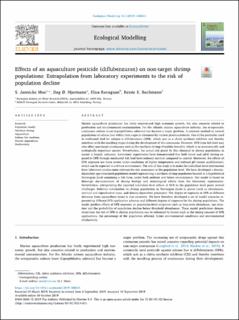| dc.description.abstract | Marine aquaculture production has lately experienced high economic growth, but also concerns related to production and environmental contamination. For the Atlantic salmon aquaculture industry, the ectoparasitic crustacean salmon louse (Lepeophtheirus salmonis) has become a major problem. A common method to control populations of salmon lice within farm cages is treatment by various pharmaceuticals. One of the pesticides used in medicated feed for salmon is diflubenzuron (DFB), which acts as a chitin synthesis inhibitor and thereby interferes with the moulting stages during the development of this crustacean. However, DFB from fish feed may also affect non-target crustaceans such as the northern shrimp (Pandalus borealis), which is an economically and ecologically important species. Nevertheless, the actual risk posed by this chemical to shrimp populations in nature is largely unknown. Laboratory experiments have demonstrated that both larval and adult shrimp exposed to DFB through medicated fish feed have reduced survival compared to control. Moreover, the effects of DFB exposure are more severe under conditions of higher temperature and reduced pH (ocean acidification), which can be expected in a future environment. The aim of this study is to make the individual-level information from laboratory studies more relevant for risk assessment at the population level. We have developed a density-dependent age-structured population model representing a northern shrimp population located in a hypothetical Norwegian fjord containing a fish farm, under both ambient and future environments. Our model is based on thorough documentation of shrimp biology and toxicological effects from the laboratory experiments. Nevertheless, extrapolating the reported individual-level effects of DFB to the population level poses several challenges. Relevant information on shrimp populations in Norwegian fjords is sparse (such as abundances, survival and reproductive rates, and density-dependent processes). The degree of exposure to DFB at different distances from aquaculture farms is also uncertain. We have therefore developed a set of model scenarios representing different DFB application schemes and different degrees of exposure for the shrimp populations. The model predicts effects of DFB exposure on population-level endpoints such as long-term abundance, age structure and the probability of population decline below threshold abundances. These model predictions demonstrate how the risk of DFB to shrimp populations can be enhanced by factors such as the timing (season) of DFB applications, the percentage of the population affected, future environmental conditions and environmental stochasticity. | |

